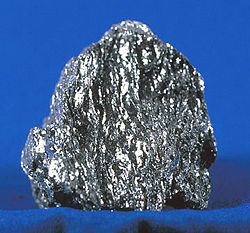Hematite
| Hematite | |
|---|---|
 |
|
| General | |
| Category | Mineral |
| Chemical formula | iron(III) oxide, Fe2O3, α-Fe2O3 |
| Identification | |
| Color | Metallic grey to earthy red |
| Crystal habit | Tabular to thick crystals |
| Crystal system | Hexagonal (rhombohedral) |
| Cleavage | None |
| Fracture | Uneven to sub-conchoidal |
| Mohs Scale hardness | 5.5 - 6.5 |
| Luster | Metallic to splendent |
| Refractive index | Opaque |
| Pleochroism | None |
| Streak | Bright red to dark red |
| Specific gravity | 4.9 - 5.3 |
Hematite (American English) or haematite (British English) is a common mineral that is mined as the principal ore of iron. Chemically, it corresponds to iron(III) oxide (Fe2O3), one of several iron oxides. It can be found in a range of colors, including black, silver-gray, and brown to reddish brown. The reddish brown color makes it suitable for use as a pigment. Polished, good quality hematite has an attractive appearance and is often used in jewelry.
Etymology
The name hematite is derived from the Greek word for blood (haima), because it is sometimes red, as in rouge, a powdered form of the mineral. It shares this root with the word hemoglobin.[1]
Occurrence
Huge deposits of hematite are found in banded iron formations. Gray hematite is typically found in places where there has been standing water or mineral hot springs, such as those in Yellowstone. The mineral can precipitate out of water and collect in layers at the bottom of a lake, spring, or other standing water. But, hematite can also occur without water, as the result of volcanic activity.
Clay-sized hematite crystals can also occur as a secondary mineral formed by weathering processes in soil, and along with other iron oxides or oxyhydroxides such as goethite, is responsible for the red color of many tropical, ancient, or otherwise highly weathered soils.
Especially good specimens of hematite come from England, Mexico, Brazil, Australia and the Lake Superior region of the United States and Canada.
Characteristics
Several varieties of hematite are known, including kidney ore, martite (pseudomorphs after magnetite), iron rose and specularite (specular hematite). While the forms of hematite vary, they all have a rust-red streak.
Hematite is harder than pure iron, but much more brittle. It crystallizes in the rhombohedral system, and it has the same crystal structure as ilmenite[2] and as corundum. Hematite and ilmenite form a complete solid solution at temperatures above 950 °C.
Hematite is an antiferromagnetic material below 260 K (the Morin transition temperature); it is weakly ferromagnetic [1] between 260 K and 948 K (the Néel temperature); and it is paramagnetic above 948 K.
Hematite is part of a complex solid solution oxyhydoxide system having various degrees of water, hydroxyl group, and vacancy substitutions that affect the mineral's magnetic and crystal chemical properties.[3] Two other end-members are referred to as protohematite and hydrohematite.
Hematite in popular culture
Polished hematite is considered by many to be a gemstone, and it has been used in jewelry over the last 50 years in North America, especially in the western United States. Its use in jewelry reached a height in Europe in Victorian times when it was very popular. Hematite can be found in jewelry and art created by the Native Americans.
See also
Notes
- ↑ Hemoglobin is the oxygen-transporting molecule in red blood cells, the iron of which causes blood to be red.
- ↑ Ilmenite corresponds to a crystalline form of iron titanium oxide, FeTiO3.
- ↑ M.-Z. Dang, D. G. Rancourt, J. E. Dutrizac, G. Lamarche, and R. Provencher, "Interplay of Surface Conditions, Particle Size, Stoichiometry, Cell Parameters, and Magnetism in Synthetic Hematite-like Materials," Hyperfine Interactions 117 (1998): 271-319.
ReferencesISBN links support NWE through referral fees
- Farndon, John. 2006. The Practical Encyclopedia of Rocks & Minerals: How to Find, Identify, Collect and Maintain the World's best Specimens, with over 1000 Photographs and Artworks. London: Lorenz Books. ISBN 0754815412 and ISBN 978-0754815419
- Klein, Cornelis, and Barbara Dutrow. 2007. Manual of Mineral Science, 23rd ed. New York: John Wiley. ISBN 0471721573 and ISBN 978-0471721574
- Pellant, Chris. 2002. Rocks and Minerals. Smithsonian Handbooks. New York: Dorling Kindersley. ISBN 0789491060 and ISBN 978-0789491060
- Shaffer, Paul R., Herbert S. Zim, and Raymond Perlman. 2001. Rocks, Gems and Minerals, Rev. ed. New York: St. Martin's Press. ISBN 1582381321 and ISBN 9781582381329
- Mindat.org. 2007. Hematite. Mindat.org. Retrieved March 21, 2007.
- Mindat.org. 2007. Martite. Mindat.org. Retrieved March 21, 2007.
- Mindat.org. 2007. Iron rose. Mindat.org. Retrieved March 21, 2007.
External links
All links retrieved June 25, 2024.
- Hematite. Webmineral.com.
Credits
New World Encyclopedia writers and editors rewrote and completed the Wikipedia article in accordance with New World Encyclopedia standards. This article abides by terms of the Creative Commons CC-by-sa 3.0 License (CC-by-sa), which may be used and disseminated with proper attribution. Credit is due under the terms of this license that can reference both the New World Encyclopedia contributors and the selfless volunteer contributors of the Wikimedia Foundation. To cite this article click here for a list of acceptable citing formats.The history of earlier contributions by wikipedians is accessible to researchers here:
The history of this article since it was imported to New World Encyclopedia:
Note: Some restrictions may apply to use of individual images which are separately licensed.



